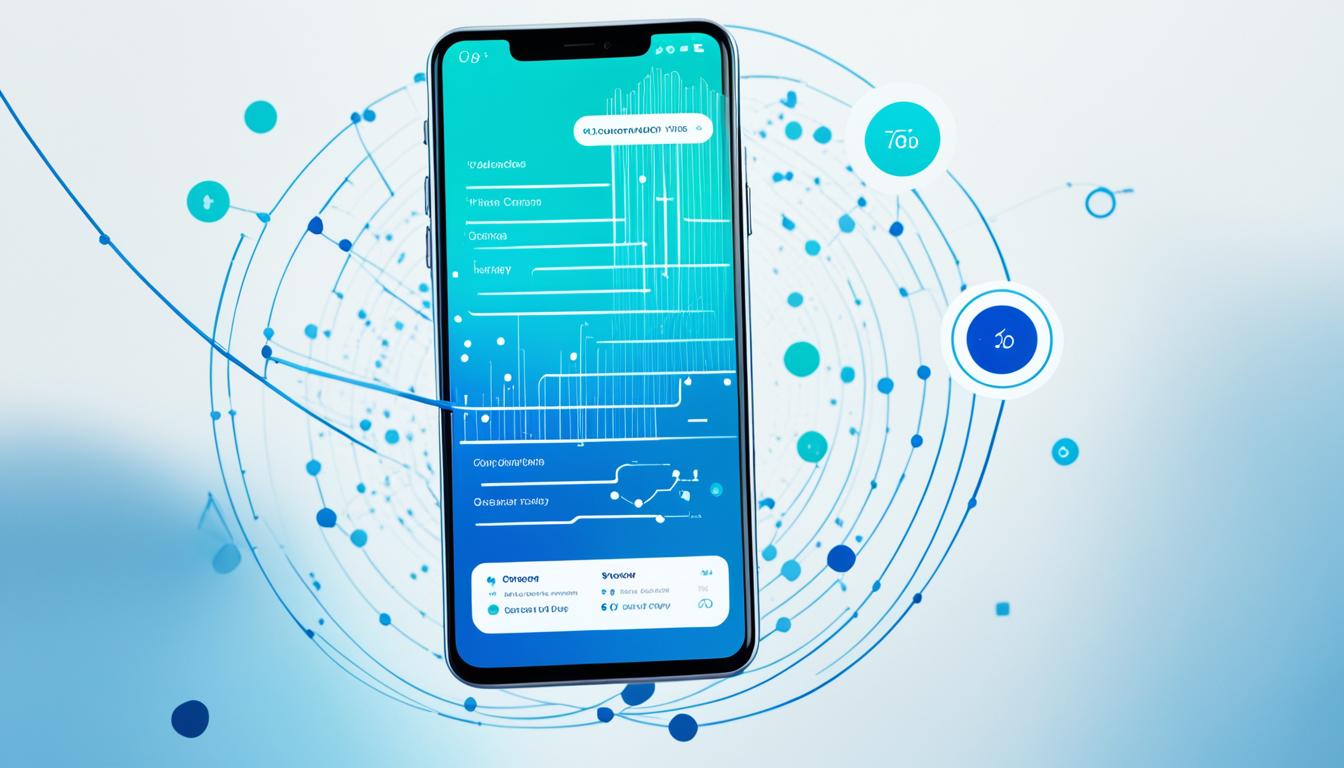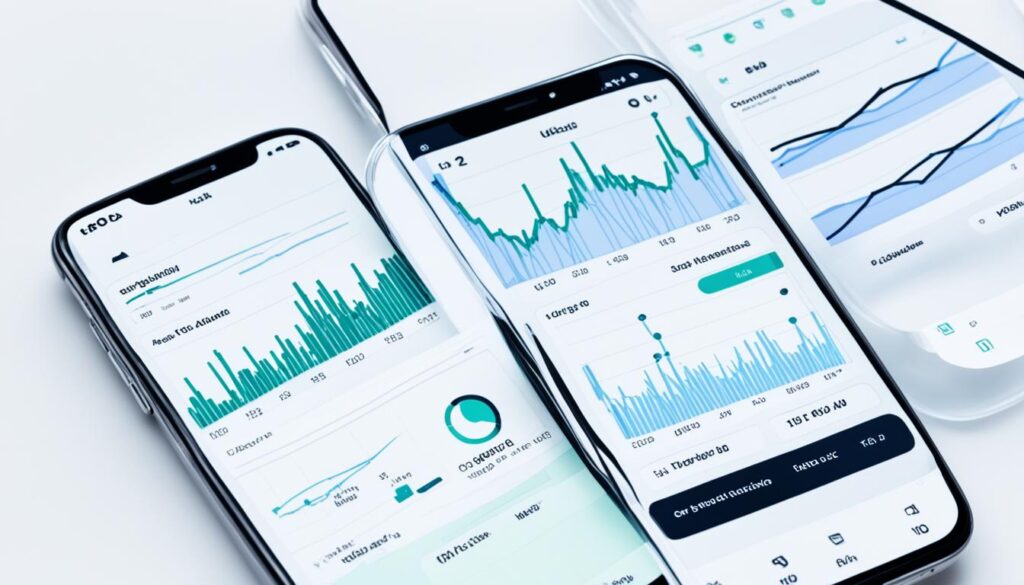In today’s fast world, we need apps that work fast and keep us connected. The need for real-time apps is huge. Node.js is changing how we make these apps by offering a powerful way to work with real-time data.
Node.js uses an event-driven approach that makes apps work better. It lets developers make apps that are fast and handle lots of real-time tasks. This includes things like chatting, getting live updates, and keeping data in sync.
Table of Contents
Key Takeaways
- Node.js is a powerful JavaScript runtime environment that enables the creation of highly scalable and responsive real-time mobile applications.
- By using the same language for both front-end and back-end development, Node.js streamlines the mobile app development process and improves code reusability.
- Node.js’s event-driven, non-blocking I/O model makes it an ideal choice for building real-time features like chat, live updates, and real-time data synchronization.
- The Node.js ecosystem offers a vast array of libraries and frameworks that simplify the development of complex mobile app features, such as WebSockets and Socket.IO.
- Effective scaling, security, performance optimization, and debugging practices are essential when using Node.js for real-time mobile app development.
What is Node.js?
Node.js is a JavaScript runtime that lets developers run JavaScript outside a web browser. It’s made for the server-side, helping create scalable and efficient apps.
Introduction to Node.js
Ryan Dahl created Node.js in 2009, using the V8 JavaScript engine. This engine is also what powers Google Chrome. Node.js uses an event-driven, asynchronous model. This lets developers make high-performance, real-time apps.
Benefits of Using Node.js
Using Node.js has many advantages for your projects:
- Fast Development: Its event-driven, non-blocking I/O model lets developers work quickly and efficiently. This makes apps scalable and fast.
- Cross-Platform Compatibility: Node.js works on Windows, macOS, and Linux. This makes it a versatile choice for developers.
- Asynchronous Programming: Node.js handles many connections at once without slowing down. This improves performance and scalability.
- Vast Ecosystem: Node.js has a huge community and lots of open-source libraries and tools. This speeds up development.
- Event-Driven Architecture: Its architecture is perfect for real-time, scalable apps. This includes chat apps, web servers, and APIs.
With Node.js, developers can make apps that handle lots of connections at once. This makes it great for real-time mobile apps.
Real-Time Mobile App Development with Node.js
In today’s fast-paced mobile app world, having real-time features and updates is key. Node.js stands out with its design for handling tasks quickly and efficiently. It’s great for making mobile apps that work well and offer lots of features.
Creating real-time mobile apps means keeping data in sync and communicating smoothly. Node.js shines here, using WebSockets and Socket.IO for instant chats, updates, and teamwork. These tools are vital for today’s mobile users who want to stay connected.
With Node.js, developers can make apps that are fun and interactive. Whether it’s messaging apps, live updates, or team projects, the options are vast. Node.js handles many users well, keeping apps fast and reliable.
For apps that need to update fast, like messaging or team tools, Node.js is a top choice. It combines real-time power with JavaScript’s wide use, making it a favorite for mobile app makers. They use it to create amazing user experiences.
| Real-Time Feature | Benefit |
|---|---|
| WebSockets and Socket.IO | Enabling instant communication, push notifications, and live updates |
| Collaborative apps | Fostering real-time teamwork and shared experiences |
| Instant messaging | Providing users with seamless and responsive communication |
“Node.js’s asynchronous and event-driven architecture makes it a perfect fit for building responsive, scalable, and feature-rich real-time mobile applications.”
Setting Up the Node.js Environment
Creating a strong Node.js development environment is key to making powerful real-time mobile apps. This guide will help you install Node.js and set up your tools. It’s all you need to get your project off the ground.
Installing Node.js
Start by installing Node.js on your computer. It works on Windows, macOS, and Linux. Just go to the Node.js website, download the installer for your system, and follow the steps to install it.
Configuring the Development Environment
After installing Node.js, set up your development space. Pick an IDE like Visual Studio Code or WebStorm that supports Node.js. Then, add important tools and plugins. These include:
- Node.js version management tools like nvm (Node Version Manager) or n to switch between different Node.js versions on your system.
- The npm (Node Package Manager) for installing and managing Node.js packages and dependencies.
- IDE-specific Node.js tools and plugins that improve your development, like linters, debuggers, and code completion features.
| Tool | Description |
|---|---|
| nvm (Node Version Manager) | Allows you to easily switch between different versions of Node.js on your system. |
| npm (Node Package Manager) | The default package manager for Node.js, used to install and manage dependencies. |
| Visual Studio Code | A popular IDE with built-in support for Node.js development and a wide range of useful extensions. |
By doing these steps, you’ll have a full Node.js development environment ready. You can now start making real-time mobile apps.
Building Real-Time Features with Node.js
Node.js is a top choice for making real-time mobile apps. It combines WebSockets and Socket.IO, key tech for fast communication between clients and servers.
WebSockets and Socket.IO
WebSockets let data flow both ways between the client and server instantly. With Socket.IO, adding instant messaging, live data updates, and collaborative experiences to apps is easy.
WebSockets keep a constant connection, making real-time communication and event-driven architecture possible. This means apps can update instantly, making users happier.
“WebSockets and Socket.IO are game-changers for building real-time features in mobile apps. They enable seamless, bidirectional communication, unlocking a new world of interactive and collaborative experiences.”
Using Node.js, developers can use WebSockets and Socket.IO to make apps that:
- Real-time updates for apps that need lots of data
- Collaborative features for working together
- Instant messaging for easy chat
- Efficient live data streaming and event-driven architecture
These techs open up new possibilities for mobile apps. They give users amazing experiences and help apps stand out.
Using Node.js for Real-Time Mobile App Development
Node.js is a top choice for making mobile apps that work fast and grow easily. It’s great for apps that need quick updates and smooth user experiences.
Using Node.js for mobile app development means your app can handle lots of users at once. This is key for apps like chat services, live streams, or games with many players. Node.js’s event-driven architecture makes sure these apps work well, even with lots of users.
Node.js also makes apps that react fast to what users do. This is key for a good user experience. It means apps feel quick and responsive, even when lots of people are using them.
Adding Node.js to popular mobile app frameworks and cross-platform development methods boosts real-time apps. Developers can use Node.js’s strengths with frameworks like React Native, Flutter, or Ionic. This makes cross-platform mobile apps that work well on many devices and platforms.
“Node.js’s event-driven, asynchronous architecture makes it an ideal choice for building scalable, responsive, and real-time mobile applications.”
In summary, Node.js and mobile app frameworks offer a strong way to make real-time mobile apps that users love. By using Node.js, developers can make apps that are scalable, responsive, and cross-platform. These apps give users amazing experiences.
Handling Real-Time Data with Node.js
In the fast-paced world of mobile app development, handling real-time data is key. Node.js stands out with its ability to process and deliver data quickly. It’s great for handling real-time data streams and building scalable systems.
Streaming Data with Node.js
Node.js is great at streaming data. It efficiently handles I/O operations, making it easy to send and receive large data sets in real-time. This is perfect for apps that need updates often, like live sports scores or stock tickers.
Implementing the Pub/Sub Pattern
The Pub/Sub pattern is another way to manage real-time data in Node.js apps. It uses an event-driven approach for efficient data processing and updates. This pattern helps in building apps that can handle lots of data without getting slow.
“Node.js’s event-driven, non-blocking I/O model makes it well-suited for building real-time applications that require efficient data streaming and scalable data handling.”
Node.js is a game-changer for apps that need constant updates. Whether it’s a live dashboard, a tool for real-time collaboration, or an app that updates often, Node.js makes it all possible. It ensures a smooth and fast user experience.
Scaling Node.js Applications
As your Node.js app grows, handling more traffic and data becomes key. Load balancing and clustering are two main ways to scale your app. These strategies help your app handle more users and data smoothly.
Load Balancing
Load balancing spreads the workload across many servers. This makes your app available to everyone and uses resources well. By using tools like Nginx or Amazon Elastic Load Balancing, your app can easily grow to meet more user activity and data needs.
Clustering
Clustering uses many CPU cores or servers to boost your app’s power and reliability. It’s great for tasks that use a lot of resources, like real-time data processing. Clustering spreads work across many processes, making your app run better and use resources well.
| Scaling Technique | Benefits | Considerations |
|---|---|---|
| Load Balancing |
|
|
| Clustering |
|
|
Using these strategies, your Node.js app can handle more users and data smoothly. This ensures a great experience for your users and keeps your app scalable and flexible.
“Scalability is not just about handling more users or data; it’s about building resilient, high-performance systems that can adapt to changing requirements and conditions.”
Integrating Node.js with Mobile Frameworks
In the world of making mobile apps, using Node.js with frameworks like React Native, Flutter, Ionic, and Cordova has changed the game. This team-up lets developers use Node.js for strong backend services and real-time features. At the same time, the mobile frameworks take care of the user interface and the specific needs of each platform.
This method has many benefits. By combining Node.js with mobile app frameworks, developers can make apps that work well on many platforms, including iOS and Android. This cuts down on development time and costs and makes sure users have the same experience on all devices.
Also, being able to reuse code between the backend and frontend makes things more efficient. Developers can use their Node.js skills to work on the server-side. The mobile frameworks then take care of the client-side, making a complete and scalable solution.
Using Node.js with mobile frameworks also lets developers make mobile apps that are fast and full of features. By using Node.js’s real-time abilities, apps can handle real-time data streams, push notifications, and more. This gives users a mobile experience that’s engaging and immersive.
| Mobile App Framework | Key Features | Advantages with Node.js Integration |
|---|---|---|
| React Native | JavaScript-based, cross-platform development | Improved performance, robust backend services, and real-time features |
| Flutter | Cross-platform development using Dart language | Seamless integration of backend logic, real-time data handling, and scalable architecture |
| Ionic | HTML, CSS, and JavaScript-based hybrid app development | Faster development, enhanced functionality, and scalable server-side solutions |
| Cordova | Cross-platform development using web technologies | Robust backend integration, real-time capabilities, and improved user experiences |
By using Node.js with mobile app frameworks, developers can open up new possibilities in cross-platform development. They can make mobile apps that are innovative and respond quickly. These apps can capture users’ attention and help businesses succeed.
Security Considerations for Real-Time Mobile Apps
Mobile app development is growing, with a big focus on real-time features. This makes mobile app security more important than ever. It’s crucial for companies and developers to keep user info safe and protect their apps.
Authentication and Authorization
For real-time mobile apps, authentication and authorization are key. Using secure ways to check who you are, like JSON Web Tokens (JWT) and OAuth, stops unauthorized access. This makes sure only the right people can use the app’s real-time features.
Data Encryption
Keeping data safe is another big part of real-time app security. This means using secure ways to send data and keeping it safe when it’s stored. HTTPS and strong encryption help protect user info, even if there’s a security issue.
| Security Measure | Description |
|---|---|
| Authentication | Secure user identification and access control, such as JWT and OAuth |
| Data Encryption | Protecting data in transit and at rest, using HTTPS and advanced encryption algorithms |
| Secure Communication | Ensuring secure real-time data exchange between the mobile app and the server |
By using these security steps, developers can make apps that are fun for users and keep their info safe. This builds trust and makes the app more secure.
“Security should be a top priority when building real-time mobile applications, as the constant exchange of data and user interactions require a robust and comprehensive security framework.”
Performance Optimization for Node.js Apps
Node.js is getting more popular, making it key to optimize its performance. By using Node.js’s unique way of handling tasks, developers can make their apps faster and more efficient. This is especially true for real-time mobile apps.
Understanding the event loop is crucial for Node.js performance. The event loop manages tasks one at a time, making sure the app doesn’t get stuck on any one task. By making the event loop work better, apps can handle tasks faster, making them more responsive and able to handle more users.
Caching is another way to boost Node.js performance. It saves data that apps use a lot, making the server work less hard. This makes the app faster for users. Load testing and profiling also help find and fix slow spots in the app, making it run smoother.
| Optimization Technique | Description |
|---|---|
| Asynchronous Programming | Leveraging Node.js’s event-driven, non-blocking I/O model to improve responsiveness and scalability. |
| Event Loop Optimization | Ensuring efficient management of the event loop to minimize time spent on I/O tasks. |
| Caching | Implementing intelligent caching strategies to reduce server load and improve response times. |
| Load Testing | Performing rigorous load testing to identify and address performance bottlenecks. |
| Profiling | Utilizing profiling tools to analyze and optimize the performance of Node.js applications. |
| Monitoring | Implementing robust monitoring solutions to track and address performance issues in real-time. |
By using these techniques, developers can make Node.js apps fast, efficient, and ready for real-time mobile use. This means a better experience for users.
Debugging and Monitoring Node.js Applications
Creating strong and dependable real-time mobile apps with Node.js means knowing how to debug and monitor them. It’s key to use Node.js debugging to find and fix problems during development and deployment. This keeps your app running smoothly.
Debugging Techniques
Node.js has a built-in debugger for developers to go through their code, set stops, and check how it runs. There are also third-party tools like Node Inspector and Debug. These tools add more features, including remote debugging and checking code coverage.
Monitoring Tools and Practices
It’s important to watch how your Node.js app is doing to catch problems early. Tools like Application Performance Monitoring (APM) give you insights into your app’s performance. They show things like how fast requests are handled, how much resources are used, and how many errors there are.
Using both debugging and monitoring tools helps you understand your app better. You can spot and fix problems fast. This way, you can make sure your real-time mobile app works well for users.
“Effective debugging and monitoring are essential for building reliable and scalable Node.js applications. By understanding the available tools and best practices, developers can ensure the smooth operation of their real-time mobile apps.”
Best Practices for Node.js Development
Creating strong and scalable real-time mobile apps with Node.js means following best practices. It’s key to organize code well, separating different parts and making projects easy to maintain. Handling errors properly is also vital, with good logging to help fix and monitor issues.
Using patterns like Promises and async/await is crucial for making Node.js apps fast and responsive. Managing dependencies well is also important. This includes keeping them updated and protecting them from security risks.
Security is a top priority for real-time mobile apps. This means using strong ways to check who can access data and encrypting data. Improving Node.js app performance with caching, load balancing, and clustering can make users happier.













